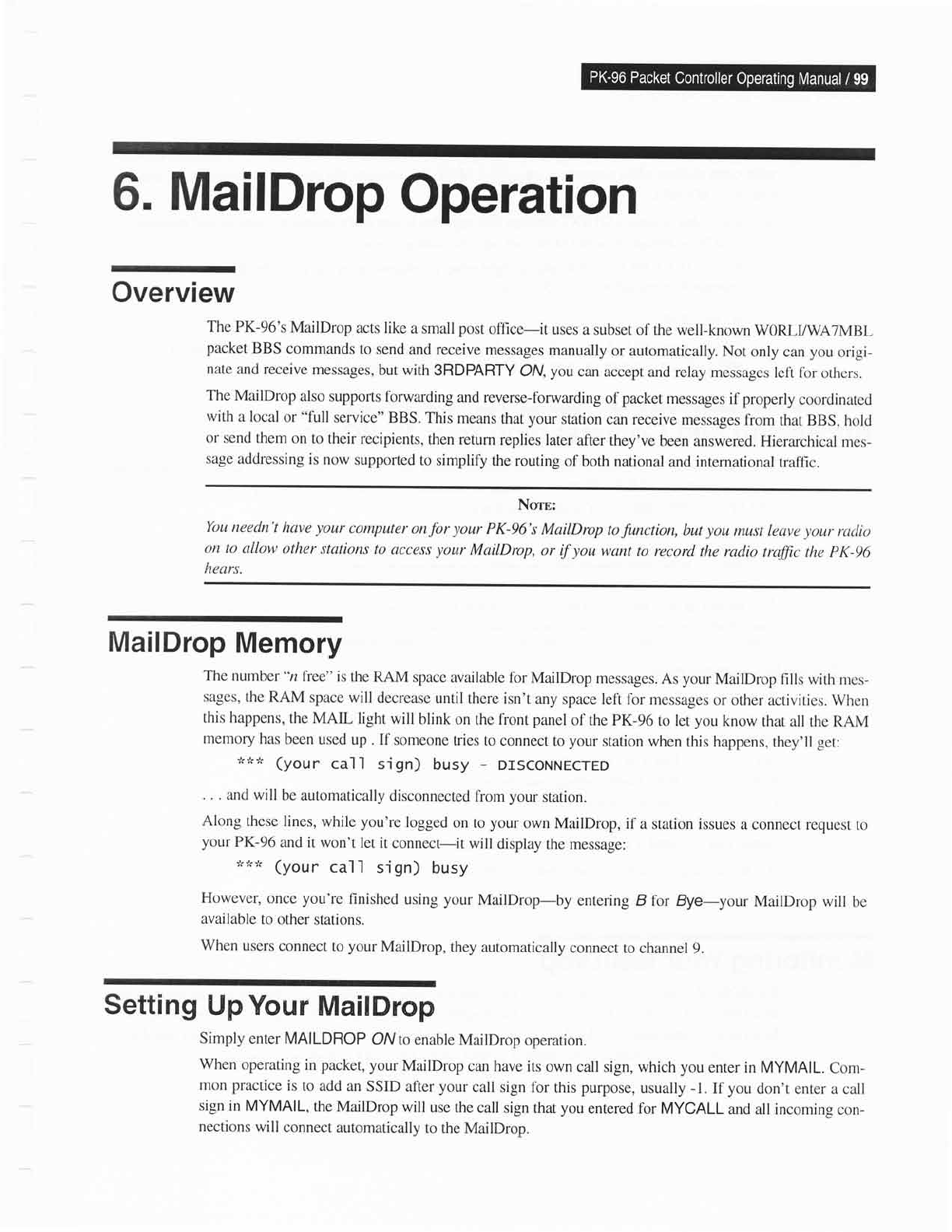Specifications
Table Of Contents

6. MailDrop
Operation
Overview
The PK-96's
MailDrop
acts
like a
small
post
oflice-it
uses
a subser
of rhe well-known
W0RLI/WATMBL
packet
BBS
commands
to send
and receive
messages
manually
or automatically.
Not
only
can
you
origi-
nate
and receive
messages,
but with
3RDPARTY
ON,
you
can accept and
relay messages
left
Ibr others.
The
MailDrop
also
supports
forwarding
and
reverse-forwarding
of
packet
messages
if
properly
coordinated
with
a local
or
"full
service"
BBS.
This means
that
your
station
can receive
messages
fiom
that BBS.
hold
or send
them
on
to their recipients,
then retum
replies later
after
they've
been answered.
Hierarchical
mes-
sage
addressing
is now
supported
to
simplify
the
routing of both
national
and international
trafllc.
Norn:
You
needn't
have
your
computer
onfor
your
PK-96's
MailDrop
to
function,
but
you
must
lecue
your
ratlir,t
on to
allow
other stations
to access your
MailDrop,
or if
youwant
to
record
the radio
traffic the PK-96
hears.
MailDrop
Memory
The
number
"n
free" is
the RAM
space available
for
MailDrop
messages.
As
your
MaitDrop fills
with mes-
sages,
the RAM
space will
decrease
until
there isn't
any space
left for
messages
or other
activities. When
this happens,
the MAIL
light will
blink
on the front
panel
of the PK-96
ro ler
you
know
thar all
the
RAM
memory
has
been used
up . If
someone
tries to
connect to
your
station when
this happens,
they'll
get:
r'rr*
(your
ca-|1
sign)
busy
-
DrscoNNEcTED
. . . and
will
be automatically
disconnected
from
your
station.
Along
these lines,
while
you're
logged
on to
your
own
MailDrop,
if a
station issues
a connect request
to
your
PK-96
and it
won't let
it
connect-it
will display
rhe
message:
r'rrtr
(you
r
ca1 1
si
gn)
busy
However,
once you're
finished
using your
MailDrop-by
entering
B for Bye-your
MailDrop
will
be
available
to
other stations.
when
users connect
to
your
MailDrop,
they automatically
connect to
channel
9.
Setting
Up
Your
MailDrop
Simply
enter MAILDROP
ONto
enable
MailDrop
operarion.
When
operating
in
packet,
your
MailDrop
can have
its
own call
sign, which
you
enter in MYMAIL.
Com-
mon practice
is
to add an
SSID after your
call sign for
this
purpose,
usually -1.
If you
don'r
enter a call
sign
in MYMAIL,
the MailDrop
will
use the
call sign
that
you
entered for
MYCALL
and all incoming
con-
nections
will
connect
automatically
to the MailDrop.










